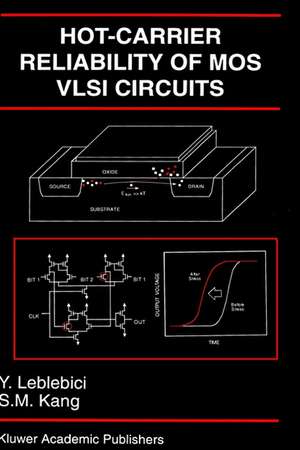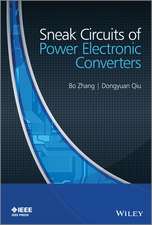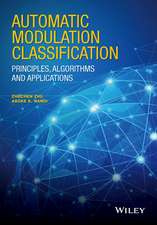Hot-Carrier Reliability of MOS VLSI Circuits: The Springer International Series in Engineering and Computer Science, cartea 227
Autor Yusuf Leblebici, Sung-Mo (Steve) Kangen Limba Engleză Hardback – 30 iun 1993
| Toate formatele și edițiile | Preț | Express |
|---|---|---|
| Paperback (1) | 1213.97 lei 6-8 săpt. | |
| Springer Us – 27 sep 2012 | 1213.97 lei 6-8 săpt. | |
| Hardback (1) | 1219.94 lei 6-8 săpt. | |
| Springer Us – 30 iun 1993 | 1219.94 lei 6-8 săpt. |
Din seria The Springer International Series in Engineering and Computer Science
- 24%
 Preț: 1041.98 lei
Preț: 1041.98 lei - 20%
 Preț: 643.50 lei
Preț: 643.50 lei - 18%
 Preț: 1225.62 lei
Preț: 1225.62 lei - 18%
 Preț: 965.02 lei
Preț: 965.02 lei - 20%
 Preț: 646.12 lei
Preț: 646.12 lei - 18%
 Preț: 948.79 lei
Preț: 948.79 lei - 20%
 Preț: 646.62 lei
Preț: 646.62 lei - 15%
 Preț: 637.46 lei
Preț: 637.46 lei - 20%
 Preț: 643.83 lei
Preț: 643.83 lei - 18%
 Preț: 949.23 lei
Preț: 949.23 lei - 20%
 Preț: 644.48 lei
Preț: 644.48 lei - 20%
 Preț: 994.92 lei
Preț: 994.92 lei - 20%
 Preț: 645.97 lei
Preț: 645.97 lei - 18%
 Preț: 946.87 lei
Preț: 946.87 lei - 20%
 Preț: 995.57 lei
Preț: 995.57 lei - 18%
 Preț: 956.99 lei
Preț: 956.99 lei - 20%
 Preț: 644.98 lei
Preț: 644.98 lei - 15%
 Preț: 649.54 lei
Preț: 649.54 lei - 18%
 Preț: 950.21 lei
Preț: 950.21 lei - 18%
 Preț: 1221.38 lei
Preț: 1221.38 lei - 18%
 Preț: 957.62 lei
Preț: 957.62 lei - 15%
 Preț: 643.99 lei
Preț: 643.99 lei - 18%
 Preț: 948.47 lei
Preț: 948.47 lei - 18%
 Preț: 947.35 lei
Preț: 947.35 lei - 20%
 Preț: 1284.65 lei
Preț: 1284.65 lei - 20%
 Preț: 1628.31 lei
Preț: 1628.31 lei - 20%
 Preț: 1285.78 lei
Preț: 1285.78 lei
Preț: 1219.94 lei
Preț vechi: 1487.73 lei
-18% Nou
Puncte Express: 1830
Preț estimativ în valută:
233.47€ • 242.84$ • 192.74£
233.47€ • 242.84$ • 192.74£
Carte tipărită la comandă
Livrare economică 15-29 aprilie
Preluare comenzi: 021 569.72.76
Specificații
ISBN-13: 9780792393528
ISBN-10: 079239352X
Pagini: 212
Ilustrații: XVII, 212 p.
Dimensiuni: 155 x 235 x 14 mm
Greutate: 0.51 kg
Ediția:1993
Editura: Springer Us
Colecția Springer
Seria The Springer International Series in Engineering and Computer Science
Locul publicării:New York, NY, United States
ISBN-10: 079239352X
Pagini: 212
Ilustrații: XVII, 212 p.
Dimensiuni: 155 x 235 x 14 mm
Greutate: 0.51 kg
Ediția:1993
Editura: Springer Us
Colecția Springer
Seria The Springer International Series in Engineering and Computer Science
Locul publicării:New York, NY, United States
Public țintă
ResearchCuprins
1. Introduction.- 1.1. The Concept of IC Reliability.- 1.2. Design-for-Reliability.- 1.3. VLSI Reliability Problems.- 1.4. Gradual Degradation versus Catastrophic Failures.- 1.5. Hot-Carrier Effects.- 1.6. Overview of the Book.- References.- 2. Oxide Degradation Mechanisms in Mos Transistors.- 2.1. Introduction.- 2.2. MOS Transistor: A Qualitative View.- 2.3. The Nature of Gate Oxide Damage in MOSFETs.- 2.4. Injection of Hot Carriers into Gate Oxide.- 2.5. Oxide Traps and Charge Trapping.- 2.6. Interface Trap Generation.- 2.7. Bias Dependence of Degradation Mechanisms.- 2.8. Degradation under Dynamic Operating Conditions.- 2.9. Effects of Hot-Carrier Damage on Device Characteristics.- 2.10. Hot-Carrier Induced Degradation of pMOS Transistors.- References.- 3.Modeling of Degradation Mechanisms.- 3.1. Preliminary Remarks.- 3.2. Quasi-Elastic Scattering Current Model.- 3.3. Charge (Electron) Trapping Model.- 3.4. Impact Ionization Current Model.- 3.5. Interface Trap Generation Model.- 3.6. Trap Generation under Dynamic Operating Conditions.- References.- 4. Modeling of Damaged Mosfets.- 4.1. Introduction.- 4.2. Representation of Hot-Carrier Induced Oxide Damage.- 4.3. Two-Dimensional Modeling of Damaged MOSFETs.- 4.4. Empirical One-Dimensional Modeling.- 4.5. An Analytical Damaged MOSFET Model.- 4.6. Consideration of Channel Velocity Limitations.- 4.7. Pseudo Two-Dimensional Modeling of Damaged MOSFETs.- 4.8. Table-Based Modeling Approaches.- References.- 5. Transistor-Level Simulation for Circuit Reliability.- 5.1. Introduction.- 5.2. Review of Circuit Reliability Simulation Tools.- 5.3. Circuit Reliability Simulation Using iSMILE: A Case Study.- 5.4. Circuit Simulation Examples.- 5.5. Evaluation of the Simulation Algorithm.- 5.6. Identification of Critical Devices.- References.- 6. Fast Timing Simulation for Circuit Reliability.- 6.1. Introduction.- 6.2. ILLIADS-R: A Fast Timing and Reliability Simulator.- 6.3. Fast Dynamic Reliability Simulation.- 6.4. Circuit Simulation Examples with ILLIADS-R.- 6.5. iDSIM2: Hierarchical Circuit Reliability Simulation.- References.- 7. Macromodeling of Hot-Carrier Induced Degradation in Mos Circuits.- 7.1. Introduction.- 7.2. Macromodel Development: Starting Assumptions.- 7.3. Degradation Macromodel for CMOS Inverters.- 7.4. Degradation Macromodel for nMOS Pass Gates.- 7.5. Application of the Macromodel to Inverter Chain Circuits.- 7.6. Application of the Macromodel to CMOS Logic Circuits.- References.- 8. Circuit Design for Reliability.- 8.1. Introduction.- 8.2. Device-Level Measures.- 8.3. Circuit-Level Measures.- 8.4. Rule-Based Diagnosis of Circuit Reliability.- References.


















